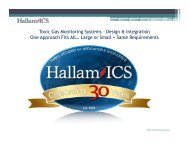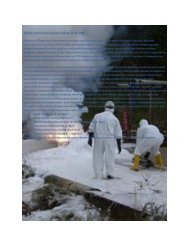Jeffrey Williams - Semiconductor Safety Association
Jeffrey Williams - Semiconductor Safety Association
Jeffrey Williams - Semiconductor Safety Association
You also want an ePaper? Increase the reach of your titles
YUMPU automatically turns print PDFs into web optimized ePapers that Google loves.
Overview of the <strong>Semiconductor</strong><br />
Emergency Response Forum<br />
(SERF) Manual<br />
Duane Caldwell<br />
Corp. <strong>Safety</strong> Program Manager, Seagate Technology<br />
<strong>Jeffrey</strong> <strong>Williams</strong><br />
Sr. Environmental Engineer, Department of Defense<br />
SSA2000 Arlington, VA
Introduction<br />
• Presentation will not distribute copies of<br />
manual or provide details of all sections of<br />
manual<br />
• Presentation will:<br />
– inform attendees of SERF activities,<br />
opportunities & products (e.g., the manual &<br />
benchmarking results)<br />
– highlight ERT Best Practices from the manual<br />
– solicit additional active participants
Part One Agenda<br />
• SERF History<br />
• Participating Companies<br />
• ERT Program Structure<br />
– Scope of Operations<br />
– Program Requirements<br />
– Program Incentives<br />
• ERT Program Basics<br />
– Incident Command<br />
– Emergency Operations Centers
SERF History<br />
• 1995 - SEMATECH hosted a meeting for<br />
members to discuss issues/concerns with<br />
emergency response operations<br />
• AMD (Greg Linenfelser) led follow-up<br />
meetings and distribution of a survey in<br />
1996. SERF named. Participation<br />
expanded beyond SEMATECH while<br />
remaining a sponsored working group.
SERF History (cont.)<br />
• At SEMATECH under Steve Burnett,<br />
additional surveys of best practices<br />
occurred. Latest survey occurred in 1997.<br />
• SERF manual developed by group<br />
consensus. At SSA 1998, multi-company<br />
teams were formed to write text for agreed<br />
upon chapter headings. Teams were<br />
balanced with respect to size and skills of<br />
participants ERT teams.
SERF History (cont.)<br />
• Editing at SEMATECH continued through<br />
1998 into 1999.<br />
• SERF Manual published in 1999 through<br />
efforts of 35 companies and 45 participants<br />
• SERF begins exploration of transition from<br />
SEMATECH to SSA sponsorship.
Participating Companies<br />
• AMD<br />
• Allegro Microsystems<br />
• Analog Devices<br />
• Atmel<br />
• Cherry <strong>Semiconductor</strong><br />
• Cypress <strong>Semiconductor</strong><br />
• Fairchild <strong>Semiconductor</strong><br />
• Harris <strong>Semiconductor</strong><br />
• Hewlett-Packard<br />
• Honeywell<br />
• IBM<br />
• Intel<br />
• Integrated Device Technologies<br />
• Lucent Technologies<br />
• M/A COM<br />
• Mitsubishi<br />
• Motorola<br />
• National <strong>Semiconductor</strong><br />
• NEC<br />
• Nortel<br />
• Philips <strong>Semiconductor</strong><br />
• Ramtron<br />
• RF Microdevices<br />
• Rockwell<br />
• Samsung<br />
• SEMATECH<br />
• Silicon Systems<br />
• Symbios<br />
• Texas Instruments<br />
• TSMC<br />
• Unitrode<br />
• UMC<br />
• US Department of Defense<br />
• VLSI Technologies
Scope of ERT Operations<br />
• SERF identified industry scope of<br />
operations with respect to:<br />
– Chemical spills/gas releases<br />
– Fire<br />
– Medical<br />
– Natural disaster<br />
– Security<br />
– Odors<br />
– Evacuations
ERT Charters of Operation<br />
• SERF discussed charters of operation<br />
– Ensure evacuation of all personnel<br />
– Information dissemination<br />
– Notifications<br />
– Response to event<br />
– Alarm Response
ERT Program Requirements<br />
• SERF developed guidance for ERT member<br />
requirements<br />
– Physical<br />
– Medical surveillance<br />
– Language<br />
– Skills retention<br />
– Availability/shift coverage<br />
– Union Issues
ERT Program Incentives<br />
• SERF identified industry wide status of<br />
ERT program incentives<br />
– Voluntary participation v. job description<br />
– Financial compensation range<br />
– Non-financial compensation items
Incident Command System<br />
• SERF established guidance for use of the<br />
Incident Command System (ICS)<br />
– Developed and used by fire departments<br />
– Provides for unified command of response<br />
– Addresses operations, administration, support<br />
– Ensures proper lines of communication<br />
– Ensure proper span of control<br />
– Applicable on large and small scale responses
Incident Command System<br />
Incident Commander<br />
<strong>Safety</strong> O fficer<br />
Medical Officer<br />
Inform ation Officer<br />
Operations Officer<br />
Logistics Officer<br />
Entry Team Leader Back-up Team Leader Decon Team Leader
Emergency Operations Centers<br />
• SERF identified typical varieties of<br />
operations centers during response<br />
– Incident Command Post<br />
– Central Control Room<br />
– Staging Area<br />
– Response Site
Part Two Agenda<br />
• ERT Response Triggers<br />
– Defining Emergencies<br />
– Setting Goals for Response<br />
– Developing Action Plans<br />
• ERT Response & Mitigation<br />
– Various Scenarios<br />
• Program Resources<br />
• Case Study & Conclusion
ERT Response Triggers<br />
• Quick, effective, and efficient emergency<br />
responses start with:<br />
– Early detection of problems,<br />
– Quick definition of the situation and its hazards,<br />
– Implementation of comprehensive action plans.
Defining Emergencies:<br />
Investigation of Problem Reports<br />
• SERF provides guidance for investigating<br />
problem reports and defining responses.<br />
– Odors, unidentified<br />
– Medical incidents<br />
– Gas alarms and odors<br />
– Chemical spills<br />
– Fire and Smoke incidents
Defining Emergencies:<br />
Gathering Data<br />
• SERF provides guidance for gathering data<br />
essential to defining events and identifying<br />
hazards.<br />
– Nature of the event<br />
– Types of hazards<br />
– Contributing conditions (e.g., perforated floors,<br />
air flow patterns, sensitive populations, etc.)<br />
– Missing or injured employees
Setting Response Goals:<br />
Essential Activities<br />
• SERF provides guidance for setting goals<br />
and objectives for responses.<br />
– Rescue<br />
– Quantification of Hazards (e.g., air<br />
concentrations of contaminants)<br />
– Observation of Conditions (e.g., open drains,<br />
ignition sources, damaged equipment)<br />
– Corrective Action<br />
– Protect (People, Environment, Property)
Developing Action Plans:<br />
Assembling Response Resources<br />
• SERF provides guidance for determining<br />
resources required for successful entries and<br />
responses.<br />
– Personnel and Teams<br />
– PPE<br />
– Monitoring Equipment<br />
– Tools and Supplies<br />
– Decontamination Stations
Developing Action Plans:<br />
Model Scenario Flow Charts<br />
• SERF provides example flow charts from<br />
operating fab sites for various scenarios.<br />
– Chemical Release<br />
• Non-specific<br />
• Hazardous liquid or solid<br />
– Smoke and Fire/Explosion<br />
– Tornado/Severe Weather<br />
– Bomb Threat<br />
– Building Evacuation
Developing Action Plans:<br />
Disaster Planning<br />
• Planning Process & Guidance<br />
– Analyze Hazards<br />
– Survey Organization<br />
– Develop Emergency Management Organization<br />
– Identify Emergency Functions<br />
– Develop Response Tools (e.g., checklists)<br />
– Develop Capability<br />
– Maintain & Evaluate Readiness<br />
– Revise
Developing Action Plans:<br />
Business Resumption Planning<br />
• Recovery Planning Process & Guidelines<br />
– Identify Critical Business Functions<br />
– Perform a Risk Analysis<br />
– Document the Recovery Procedures<br />
– Training & Validation
ERT Response & Mitigation:<br />
Techniques & Guidelines<br />
• SERF lists techniques and guidance for<br />
responding to and mitigating various<br />
hazardous conditions.<br />
– Gas Releases/Fires (e.g, SiH 4 and ClF 3 )<br />
– Chemical Spills (by hazard class)<br />
– Injuries/Illnesses (universal precautions)<br />
– Natural & Technological Disasters (e.g.,<br />
earthquakes, severe weather, power failure)<br />
– Bomb Threats
ERT Response & Mitigation:<br />
Techniques & Guidelines<br />
• SERF describes examples of<br />
decontamination techniques and procedures.<br />
– Equipment<br />
– Personnel<br />
• SERF discusses training techniques and<br />
curriculum, and provides some examples of<br />
drill scenarios and evaluations.
Program Resources:<br />
References<br />
• Glossary<br />
• Guidance for Developing ERT Documents<br />
– site & system maps<br />
– contact lists<br />
– equipment lists & manuals<br />
• List of Recommended Books<br />
• List of Recommended Internet Sites<br />
• SERF Member Company Contacts
Program Resources:<br />
Hazardous Materials Inventory<br />
ample HMIS Form.xls<br />
Double-click Icon to view document
Program Resources:<br />
ERT Equipment Inventory<br />
Sample ERT<br />
Equipment Inventory<br />
Double-click Icon to view document
Program Resources:<br />
Emergency Contact Matrix<br />
Emergency Contact<br />
Matrix<br />
Double-click Icon to view document
Case Study:<br />
Chemical Release Flow Charts<br />
nidentified Chemical<br />
Release.jpg<br />
Release<br />
Classification.jpg<br />
Double-click Icons to view documents<br />
Hazardous Material<br />
Release.jpg
Conclusion<br />
• SERF depends on active participation from<br />
a wide range of companies and geographic<br />
regions.<br />
• The SERF Manual is a first draft of<br />
consensus practices and sample documents<br />
that should be expanded and refined, using<br />
an even larger group of contributors.
SERF Contacts<br />
• Interested parties should contact:<br />
– Peter Monti, Department of Defense<br />
301.688.0120<br />
– Lori Strong, SSA<br />
703.790.1745




